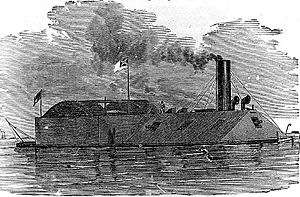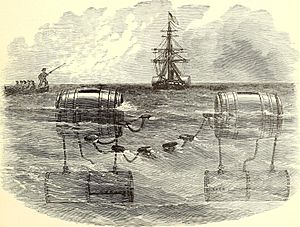CSS Baltic facts for kids
class="infobox " style="float: right; clear: right; width: 315px; border-spacing: 2px; text-align: left; font-size: 90%;"
| colspan="2" style="text-align: center; font-size: 90%; line-height: 1.5em;" | 
|}
The CSS Baltic was a special kind of warship called a casemate ironclad. It served in the Confederate States Navy during the American Civil War. Before the war, it was a towboat and a cotton lighter (a type of barge).
The state of Alabama bought the Baltic in December 1861. They wanted to turn it into an ironclad warship. In May 1862, it joined the Confederate Navy. The Baltic then served in Mobile Bay near the Gulf of Mexico.
The ship was not in great shape during its service. A historian named William N. Still Jr. called it "a nondescript vessel." This means it was not very special or well-known. Over time, parts of the ship's wood structure started to rot. In 1864, its armor was taken off to be used on another ironclad, the CSS Nashville.
By August 1864, the Baltic was no longer in active service. Near the end of the war, it was moved up the Tombigbee River. Union forces captured it on May 10, 1865. An inspection found that its upper hull (the main body of the ship) and deck were rotten. Its boilers (which made steam for the engines) were also unsafe. The Baltic was sold on December 31, 1865. It was probably taken apart in 1866.
Contents
Why the Baltic Was Built
The American Civil War started in 1861. It was mainly about slavery, which was common in the Southern states. When Abraham Lincoln, who was against slavery, became president in 1860, several Southern states left the United States. They formed the Confederate States of America.
The war began when the Confederates attacked Fort Sumter on April 12, 1861. At the start of the war, the Confederates had a weak navy. They didn't have many ships or places to build them. The Union Navy was much stronger.
The Union had a plan called the Anaconda Plan. It aimed to blockade the Confederate coastline. This would stop trade and prevent the South from getting weapons. Because of this, protecting the coast became very important for the Confederates. Both the Confederate government and individual states started building up their defenses.
About the Baltic
The Baltic was built in 1860 in Philadelphia, Pennsylvania. Not much is known about its early life. One historian, Saxon Bisbee, said it was "one of the most obscure Confederate ironclads." This means very few records exist about it.
After it was built, the Baltic was taken to Mobile, Alabama. It was used as a towboat and to carry cotton in Mobile Bay.
In November 1861, the Alabama government decided to spend $150,000 on an ironclad. This ship would act as both a gunboat and a naval ram (a ship designed to smash into enemy ships). A special group chose the Baltic. It was a sidewheel steamer, meaning it had large wheels on its sides to move through the water. The state bought it on December 13 for $40,000.
Work to turn it into a casemate ironclad began on December 22. The ship became bigger. Its length grew to 186 feet (56.7 m), its width (beam) to 38 ft (11.6 m), and its weight (tonnage) to 624 tons. To help the hull carry the extra weight of armor and guns, special supports called hog chains were added. The ship's draft (how deep it sat in the water) was about 6 ft (1.8 m) to 7 ft (2.1 m).
The Baltic had two steam engines. Four large boilers heated water to make steam for these engines. The two paddle wheels were 29 ft (8.8 m) across. The ship could burn either wood or coal for fuel.
Because of all the changes, the Baltic became very slow. It could only go about 5 knots (9.3 km/h; 5.8 mph). This was described as "not [...] more than a man's walking pace." Most Confederate ironclads used propellers, not paddle wheels. The Baltic was one of the few paddle wheel ironclads the Confederates actually finished. It also had trouble steering. The ship had a crew of 86. Life on board was not comfortable, with poor ventilation and hot conditions. The crew often slept on land or outside.
The Baltic's bow (front) was made stronger to be used as a ram. It had six cannons. These included two Dahlgren guns and two 32-pounder guns. The other two were smaller. The ship was covered with iron plates 2.5 inches (64 mm) thick. These plates were bolted to its new wooden structure. However, the back (aft) part of the ship was only protected by bales of cotton. Not many details are known about the ship's layout after its changes.
Service History
A drawing of Confederate naval mines. The Baltichelped place mines in Mobile Bay.
On May 12, 1862, the state of Alabama gave the Baltic to the Confederate States Navy. Lieutenant James D. Johnston became its commander. The ship officially began its service that month. It operated in Mobile Bay, around Mobile, Alabama, and on the Tombigbee River.
By February 1863, the ship was too old and worn out for active fighting. Its main job became placing naval mines to protect Mobile Bay. For a while, the Baltic was the only Confederate ironclad in Mobile Bay. This was before the CSS Tennessee was finished in February 1864.
When the Tennessee was ready, Lieutenant Johnston moved to command it. Lieutenant Charles Carroll Simms then took command of the Baltic. The Baltic's condition kept getting worse in late 1863 and early 1864. By March 1864, an expert said the ship was in such bad shape that its iron armor should be removed. In May, Simms wrote that the Baltic was very rotten. He said it was "about as fit to go into action as a mud scow" (a small, simple boat).
In July, parts of the Baltic were taken apart. Some of its armor was removed and put on the ironclad CSS Nashville. After the armor was gone, engineers said the Baltics boilers were unsafe. They needed to be patched. On July 21, Simms was moved to command the Nashville. The rest of the Baltics armor was also taken for the Nashville.
By the time of the Battle of Mobile Bay in early August, the Baltic was no longer in service. As the war was ending, the Baltic, Nashville, and other ships were sent up the Tombigbee River. Union forces captured them on May 10, 1865, at Nanna Hubba Bluff.
The next month, Union officials checked the Baltic. They found that the part of its hull below the water line was fine. But the part above the water line and the deck were both rotten. The engines were still good, but the boilers were unsafe. The officials thought the Baltic could be repaired and used as a towboat again. However, this never happened. The ship was sold on December 31, 1865. It is believed that the Baltic was probably taken apart in 1866. Its poor condition and lack of future records suggest it was not used for anything else.
See also
 In Spanish: CSS Baltic para niños
In Spanish: CSS Baltic para niños
| History | |
|---|---|
| Name | Baltic |
| Launched | 1860 |
| Commissioned | May 1862 |
| Decommissioned | July 1864 |
| Captured | May 10, 1865 |
| Fate | Sold on December 31, 1865 |
| General characteristics (after changes) | |
| Type | Casemate ironclad |
| Tonnage | 624 |
| Length | 186 ft (56.7 m) (o/a) |
| Beam | 38 ft (11.6 m) |
| Draft | 6 to 7 ft (1.8 to 2.1 m) |
| Installed power | 4 × horizontal return-flue boilers |
| Propulsion | 2 × steam engines |
| Speed | 5 knots (9.3 km/h; 5.8 mph) |
| Complement | 86 officers and men |
| Armament | 2 × Dahlgren guns, 2 × 32-pounders, 2 × smaller pieces |
| Armor | 2.5 in (64 mm) |


